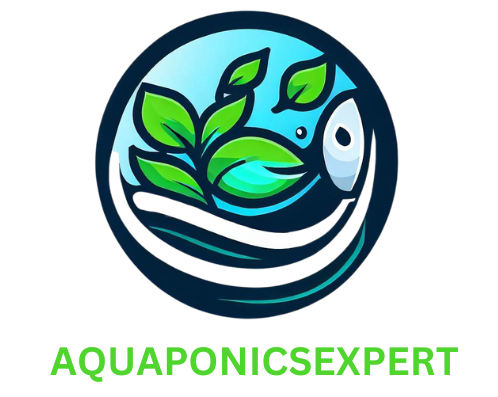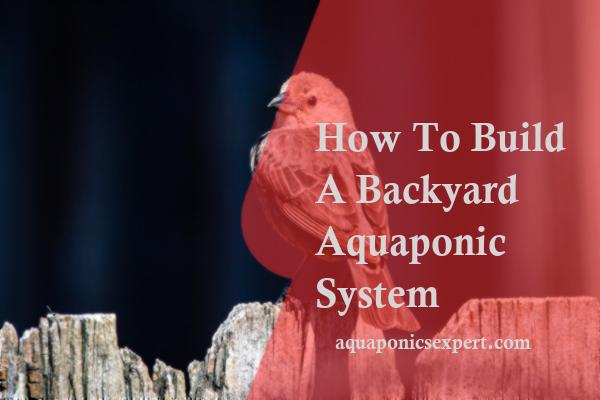How To Build A Backyard Aquaponic System
Are you tired of spending money on fresh produce at the grocery store, only to have it spoil after a few days? Would you like to have a constant supply of organic vegetables and fish right in your own backyard? If so, then building a backyard aquaponic system might be the solution for you! **Aquaponics is a sustainable and efficient method of growing plants and raising fish in a mutually beneficial system**. By utilizing the natural process of nutrient recycling, you can create a self-sustaining ecosystem that can provide you with a year-round supply of fresh and healthy food.
How To Build A Backyard Aquaponic System
Building a backyard aquaponic system can be an exciting and rewarding project. This sustainable method of gardening combines aquaculture (raising fish) with hydroponics (growing plants without soil) to create a mutually beneficial ecosystem. Here’s a step-by-step guide on how to build your own backyard aquaponic system:
1. Choose a suitable location: Find a spot in your backyard that receives sufficient sunlight and is conveniently accessible for maintenance. It should also be near a water source for easy filling and topping up.
2. Set up the fish tank: Select a fish tank that is adequately sized for the type and number of fish you plan to raise. Install an air pump and water heater to maintain optimal conditions for the fish. It is essential to regularly monitor water quality parameters such as temperature, pH levels, and ammonia levels.
3. Construct the grow bed: The grow bed will house the plants and also serve as a biological filter for the fish tank. It can be made of various materials such as wood, plastic, or concrete. Ensure proper drainage by adding a layer of gravel or clay pellets at the bottom. Fill the grow bed with a suitable growing medium like expanded clay pellets.
4. Connect the system: Use a pump to circulate water from the fish tank to the grow bed and back. This enables the plants to absorb the nutrients provided by the fish waste while also filtering the water for the fish. Ensure a proper balance between the fish load and the number of plants to avoid overloading the system.
Pro-tips: 1. Introduce fish species that are compatible with aquaponics, such as tilapia, trout, or catfish. 2. Consider adding a solids filter to remove any large debris before the water reaches the grow bed. 3. Include a biofilter for bacteria growth, which helps convert ammonia into nitrites and nitrates, essential nutrients for plants. 4. Start small and gradually expand your system as you gain experience and confidence in managing it.
By following these steps and incorporating pro-tips, you can successfully establish a backyard aquaponic system. It offers a sustainable and efficient way to grow your own fresh produce while enjoying the beauty of a thriving aquatic ecosystem right in your backyard.
Choosing The Right Location For Your Backyard Aquaponic System
An aquaponic system is a sustainable and efficient method of growing plants and raising fish in a symbiotic environment. Building a backyard aquaponic system can be a rewarding and educational project. To start, you’ll need a fish tank, where the fish will live, and a grow bed, which will hold the plants. The fish tank should be large enough to accommodate the desired number of fish, and it should have a filtration system to keep the water clean.
Next, you’ll need to connect the fish tank to the grow bed using plumbing pipes. The water from the fish tank will flow into the grow bed, where it will provide nutrients for the plants. The grow bed should be filled with a suitable growing medium, such as clay pebbles or gravel, to support plant roots. As the water circulates through the grow bed, the plants will absorb the nutrients, effectively filtering the water for the fish.
To maintain the balance of the system, you’ll need to monitor and adjust the water parameters regularly. This includes testing the water for temperature, pH levels, and ammonia content. It’s crucial to ensure that the fish are healthy and the plants are receiving adequate nutrients. Additionally, you’ll need to feed the fish daily and remove any excess waste or uneaten food to prevent water contamination. With proper care and maintenance, your backyard aquaponic system can provide you with a source of organic vegetables and fish, creating a sustainable and self-sufficient ecosystem in your own backyard.
Selecting The Appropriate Fish And Plant Species For Your Setup
Building a backyard aquaponic system is an exciting and rewarding project that combines the principles of aquaculture and hydroponics. It provides a sustainable and efficient way to grow both fish and plants simultaneously. Before beginning the construction, it is important to plan the system layout and gather the necessary materials. The main components needed include a fish tank or pond, grow beds, a water pump, a biofilter, piping, and fittings.
The first step is to set up the fish tank or pond. It should be large enough to accommodate the desired number and type of fish. Next, the grow beds should be constructed above or adjacent to the fish tank. These can be made with a variety of materials such as wood, plastic, or even repurposed containers. It is important to ensure that the grow beds are strong and secure enough to hold the weight of the growing media and plants.
Once the tanks and grow beds are in place, a water pump should be installed to circulate the water between them. The water from the fish tank is pumped up to the grow beds where it cascades over the plants, providing nutrients and oxygen. From there, the water flows back into the fish tank, completing the cycle. It is crucial to include a biofilter in the system to remove any waste or toxins produced by the fish, ensuring a clean and healthy environment for both the fish and plants. Lastly, the system should be carefully monitored and adjusted as necessary to maintain the optimal balance of water quality, fish health, and plant growth.
Assembling The Necessary Equipment And Materials For Construction
Building a backyard aquaponic system can be an exciting and rewarding project for anyone interested in gardening and sustainable food production. To begin, a suitable location in the backyard needs to be selected. The ideal spot should receive at least six hours of direct sunlight daily and have access to a water source. Once the location is determined, the next step is to construct the fish tank, which will serve as the source of nutrients for the plants. A food-grade container large enough to house the desired fish species is recommended, and it should be equipped with an efficient filtration system to maintain water quality.
The next component to consider is the grow bed, where the plants will be placed. This can be built using materials such as plastic tubs or custom-made wooden frames filled with a growing medium like expanded clay pebbles or gravel. The grow bed needs to be positioned above the fish tank so that the nutrient-rich water flows from the fish tank to the grow bed through gravity. To create this system, a plumbing setup is required, consisting of pipes, valves, and a water pump. The pump will circulate the water from the fish tank up to the grow bed and then back down to the tank, ensuring a continuous cycle.
Aquaponics also requires a method to monitor and maintain optimal water parameters. This can be achieved through various means, such as using a water testing kit to assess pH, ammonia, nitrite, and nitrate levels. Adjustments may need to be made to keep the water parameters within the suitable range for both the fish and plants. Additionally, choosing the right fish species and plants is crucial. Popular choices for aquaponics systems include tilapia, trout, and koi for fish, while lettuce, herbs, and tomatoes are common plant choices. It is essential to select species that have similar environmental requirements to ensure a successful and harmonious aquaponic system.
Setting Up The Grow Bed And Fish Tank
To build a backyard aquaponic system, there are several key steps that need to be followed. First, it is essential to select a suitable location for the system. It should have access to direct sunlight for at least six hours per day and be protected from strong winds. Next, a fish tank needs to be set up, which can be a large plastic container or an aquarium. It should be filled with water and equipped with an aerator to ensure proper oxygenation for the fish.
The next step is to build the grow bed, which will serve as the container for the plants. It can be made of various materials such as wood or plastic and should be filled with a growing medium, such as gravel or expanded clay pellets. Then, a water pump is required to circulate water from the fish tank to the grow bed. This pump should be connected to a timer or a continuous flow system to regulate the water cycle.
Lastly, it is vital to introduce the fish and the plants to the system. Hardy fish like tilapia or goldfish are commonly used in backyard aquaponics. They will provide the necessary nutrients for the plants through their waste. Once the fish are settled, vegetable seedlings or plant cuttings can be placed in the grow bed, allowing them to absorb the nutrients from the water. Regular monitoring of the water quality, including pH and ammonia levels, is crucial for maintaining a healthy system.
Cycling The System To Establish Beneficial Bacteria
Building a backyard aquaponic system is a rewarding and sustainable way to grow both fish and plants in a mutually beneficial environment. The first step in constructing this system is to choose an appropriate location in your backyard that receives ample sunlight. Once you have identified the right spot, you will need to gather the necessary materials, which include a fish tank or container, grow beds (such as large buckets or troughs), plumbing fittings, and a water pump. It is important to ensure that these components are made of durable and non-toxic materials.
Next, you will need to set up the plumbing system. This involves connecting the fish tank to the grow beds through a series of pipes and fittings. The water pump should be installed to circulate the water from the fish tank to the grow beds and back. This continuous flow of water is crucial for providing nutrients to the plants and oxygenating the fish tank. To ensure efficient filtration, a biofilter should be incorporated into the system to convert fish waste into nutrients for the plants.
Finally, it is time to introduce the fish and plants. Choose fish species that are well-suited for aquaponics, such as tilapia or trout, and make sure to provide them with appropriate food and a suitable environment. Once the fish tank is established, you can add various types of plants to the grow beds. Leafy greens, herbs, and some fruiting plants are commonly grown in aquaponic systems. It is important to monitor the system regularly, checking the water quality and pH levels, and adjusting them as necessary. With proper maintenance and care, your backyard aquaponic system can provide a sustainable source of fish and fresh produce right from your own backyard.
Maintaining Water Quality And Nutrient Levels.
Building a backyard aquaponic system can be a rewarding and sustainable way to grow your own food while also creating a balanced ecosystem. The first step in constructing a system like this is to choose a suitable location in your backyard. Look for an area that receives ample sunlight and is protected from strong winds. It should also have a stable surface, such as a patio or a leveled ground.
Next, you’ll need to gather the necessary materials. This includes a fish tank or container to house the fish, a grow bed to hold the plants, a water pump to circulate the water, and a water filtration system. Additionally, you’ll need some pipes and fittings to connect all the components. It is important to ensure these materials are made from non-toxic materials, as they will come into contact with the fish and plants.
Once you have all the materials, start by setting up the fish tank and adding the necessary water. Choose fish that are suitable for aquaponics, such as tilapia or goldfish. The fish will produce waste that will serve as nutrients for the plants. The water from the fish tank will flow into the grow bed, where the plants will be planted. As the plants absorb the nutrients from the fish waste, they will purify the water, which will then be recirculated back into the fish tank. This closed-loop system creates a symbiotic relationship between the fish and plants, allowing them to thrive together.
Building a backyard aquaponic system may require some trial and error, so make sure to do your research and consult with experts if needed. It is crucial to monitor the water temperature, pH levels, and nutrient levels to ensure optimal conditions for both the fish and plants. With patience and proper maintenance, you can enjoy a bountiful harvest of fresh vegetables, herbs, and fish from your own backyard aquaponic system.
Conclusion
In conclusion, building a backyard aquaponic system is a rewarding and sustainable way to grow fresh produce and cultivate healthy fish right in the comfort of your own home. By utilizing the symbiotic relationship between plants and fish, this system not only minimizes water usage but also eliminates the need for chemical fertilizers. With the right planning and materials, setting up your own aquaponic system can be a fun and educational project suitable for both beginners and experienced gardeners. By following the steps outlined in this guide, you can confidently embark on your journey towards creating a thriving ecosystem that not only provides you with delicious homegrown food but also contributes to a greener and more self-sufficient lifestyle.







